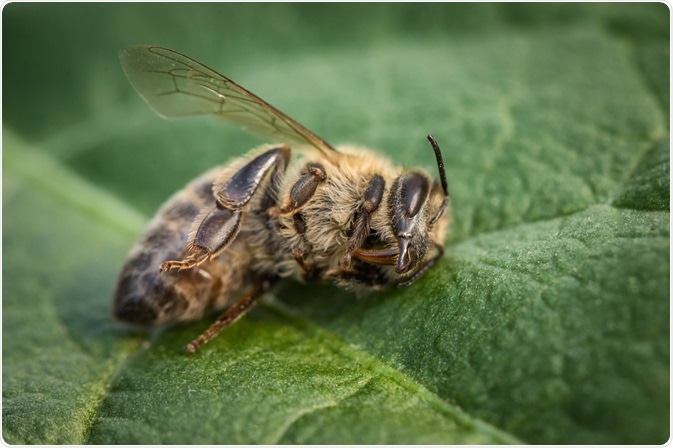Honeybees are impacted by several pathogens, including bacteria, fungi, viruses, and other parasites. American Foulbrood is one of the most potent diseases that affects the honeybee larvae of the Apis species and leads to sepsis and death of honeybee larvae.
This disease has very adverse impacts on the pollination and beekeeping industry, thus, the discovery of a specific sequence that can target this bacteria can be an effective method to detect and control this pathogen.
Until recently, there was no known cell-binding domain that could bind to Paenibacillus larva, a bacterium known to cause American Foulbrood. In this case study, researchers identified the first endolysin cell-binding domain that targets Paenibacillus larvae.

Image Credit: Valentina Proskurina/Shutterstock.com
What are Endolysins?
Endolysins are enzymes that can detect and target bacterial pathogens. There are specific endolysins that target gram-positive bacteria, and these have cell binding and an enzymatically active domain.
Endolysins are coded by bacteriophages at the end of their life cycle. These enzymes target and degrade the murein layer, thus cutting the peptidoglycan host cell wall. This releases the virions from the bacteria.
These enzymes have two functional domains: a catalytic domain and a cell wall binding domain. The cell wall domain helps in targeting specific bonds on the surface of the cell wall. Targeted attacks using the cell wall domain also offer certain advantages compared to using expensive antibodies that are time-consuming to produce, sensitive to temperature and pH, and also tend to aggregate. These factors have led to the emergence of cell-binding domains as an effective alternative to antibodies.
Current Treatment Strategies of American Foulbrood
Presently, the only way to counter this disease is incinerating the hives and equipment that are infected and infected. This causes severe economic losses to the sector. The use of antibiotics has been banned in several countries as their use leads to antibiotic resistance and also leads to the deposition of antibiotic residues in the raw honey.
This further affects the quality of honey and its safety for use in humans. Methods based on PCR have overcome many of the challenges; however, in this case, the efficiency of recovering DNA from the samples and false-positive results have comprised its success. Thus, there is a critical need in the beekeeping industry to detect and control American Foulbrood disease.
Discovery of a Cell-binding Domain that Binds to Paenibacillus Larvae.
While previous bioinformatics analysis of Paenibacillus larvae had shown the presence of a lysin but it did not detect a cell-binding domain at the C-terminus. In this study, the authors obtained a three-dimensional structure with two domains that are connected by a linker.
The first domain has a sequence that corresponds to the N-terminal catalytic domain and the second terminus consists of a disordered region, an alpha helix, a beta-strand, another alpha helix, and then a disordered region.
 Photografiero | Shutterstock
Photografiero | Shutterstock
Functional Analysis
To prove the existence of the cell-binding domain, the authors cloned the specific sequence and the peptide was further fused to a fluorescent protein. The Paenibacillus larvae cells were incubated with this cell-binding protein fused to GFP. Subsequently, imaging the cells under the microscope showed that this fusion protein was able to decorate all the P. larvae cells, suggesting its functional significance.
Identifying the Cell-binding Protein
To identify the smallest part of the peptide that still retains the ability to bind to cells, several truncated versions of the protein were tested on both C- and N-terminus. The various versions were then tested for their ability to bind to cell walls using fluorescent microscopy.
This analysis showed that when the cell-binding fragment was truncated at residue 161 or 223, its ability to bind was still present. Further alignment analysis showed that these cell-binding domains are conserved among various amidase 2 lysins, showing that they can easily be recognized.
Further Reading